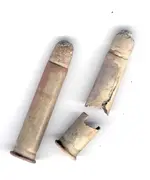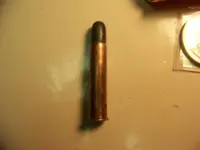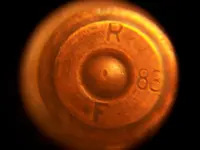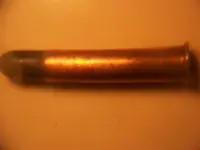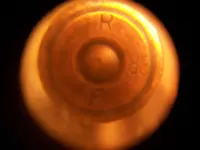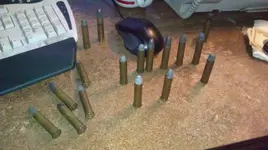The early 45-70 ammunition was inside primed without a head stamp. The earliest head stamp is a raised US Carbine, and there were only a few of those manufactured during the month of July, 1874, so one of those cartridges loaded and in decent shape will bring $300 +. The early 45-70 cartridge case itself is made from gilding metal, which is mostly copper if not all copper. The 73 Springfield trap door rifle and carbine came into the service in 1873, and except for the raised US Carbine, there was no head stamp for several years, but I don't remember exactly when they started head stamping. The inside primed cartridges also have a crease near the base of the case to hold the primer cup in place. The earliest cartridges had a bit of a gap in the creases, and later the gap narrowed. Originally the cartridge was loaded with a 420 grain bullet, over 70 grains of black powder, while the carbine cartridge was exactly the same from the outside, only it had 55 grains of powder with wads to fill the space left from the reduced charge.
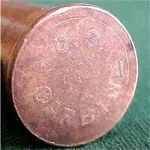
Here is an example of the first head stamp used to tell the difference from the rifle cartridge. In 1879 Springfield Armory did some testing and adopted a 500 grain bullet. The outside primed or reloadable cartridge kind of overlapped, and they were still making inside primed into the 1880's.
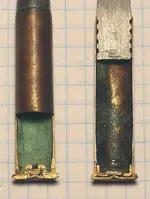
The difference in the two types of priming.
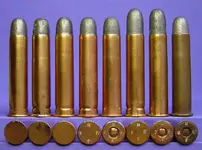
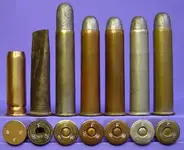
These photos show the cartridge and the head stamp. Also the difference between the 420 and the 500 grain bullet is noticeable. The short cartridge on the left of the second photo is a blank for training horses.
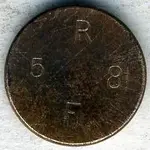
Here is an easy to see head stamp. It's inside primed, R is for rifle, if there was a c it would mean carbine, F is Frankford Arsenal, 5 means it was loaded in May, and 81 means 1881.
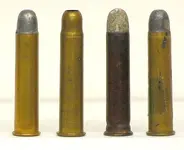
These have a couple of interesting variations, the second from the left is a gatling gun blank, and to the right of is is a copper cased inside primed. Anyhow, I know this is way more than you asked for, but you hit a subject near and dear to me. I shoot both a 73 rifle and carbine, both originals, and I'm kind of a nut for the Indian Wars. The problem with finding you a non damaged dug case is even though the inside primed case wasn't supposed to be reloadable, the Indians were able to reload them, so there was a general order issued that all fired empties were to be stomped and flattened. So it is a rare find to dig one that hasn't been flattened. I have a couple I dug, and I'm sorry, they were lost by a soldier in 1877, I won't part with them. If you don't mind a couple of more modern brass empties I can provide you with them, with either fired or unfired primers. PM me if you would like to have those. I've also discovered that the dug loaded ones the bullets are crumbling. I don't know what the alloy was in the lead in those days, but I expect the electrolysis between the different metals has a lot to do with that.










